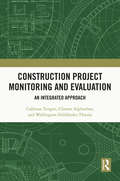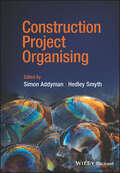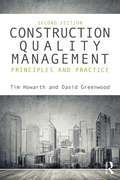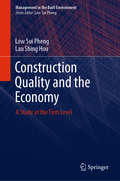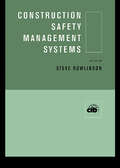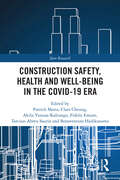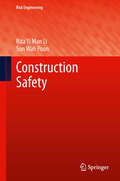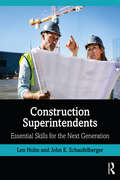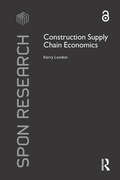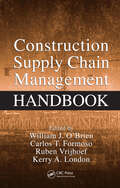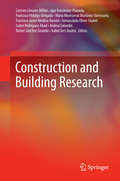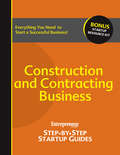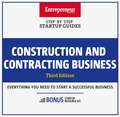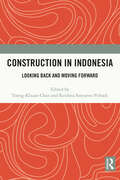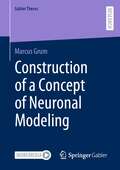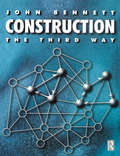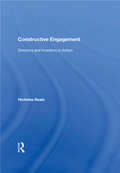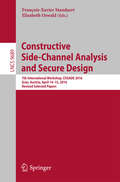- Table View
- List View
Construction Project Manager’s Pocket Book (Routledge Pocket Books)
by Duncan CartlidgeThe second edition of the Construction Project Manager’s Pocket Book maintains its coverage of a broad range of project management skills, from technical expertise to leadership, negotiation, team building and communication. However, this new edition has been updated to include: revisions to the CDM regulations, changes to the standard forms of contract and other documentation used by the project manager, the impact of BIM and emerging technologies, implications of Brexit on EU public procurement, other new procurement trends, and ethics and the project manager. Construction project management activities are tackled in the order they occur on real projects, with reference made to the RIBA Plan of Work throughout. This is the ideal concise reference which no project manager, construction manager, architect or quantity surveyor should be without.
Construction Project Manager’s Pocket Book (Routledge Pocket Books)
by Duncan CartlidgeThe third edition of the Construction Project Manager’s Pocket Book continues to guide and educate readers on the broad range of essential skills required to be a successful construction project manager. The book introduces the generic skills required by any project manager, before tackling the core skills and activities of a construction project manager with direct reference to the RIBA Plan of Work and the OGC Gateway. Key features and coverage in the new edition include:· a step-by-step explanation of construction project management from pre-construction to occupancy,· hard and soft skills, including ethics, leadership, team building,· procurement strategies,· supply chain and contract management,· feasibility studies / development appraisals,· environmental issues,· digital tools and· occupancy activities.The updates in this new edition take account of all regulatory and legislative changes, and also changing market conditions and working trends. This is the ideal concise reference that no project manager, construction manager, architect or quantity surveyor should be without.
Construction Project Monitoring and Evaluation: An Integrated Approach (Routledge Research Collections for Construction in Developing Countries)
by Clinton Aigbavboa Callistus Tengan Wellington Didibhuku ThwalaThis book will provide readers with an in-depth theoretical awareness and practical guidance on the implementation of an effective monitoring and evaluation (M&E) system to ensure construction projects meet approved quality, cost, time and social sustainability objectives. The authors discuss the drivers, challenges, determinants and benefits of effective M&E implementation together with the theories and models underpinning construction project M&E practices. Further, a comparative overview of M&E practices in developed and developing countries is presented to elucidate the best practices. The book first conceptualizes M&E as a five-factor model comprising stakeholder involvement, budgetary allocation and logistics, technical capacity and training, leadership, and communication. It then presents an M&E case study on the Ghanaian construction industry before expanding on the idea of M&E systems as an effective tool for project performance and in optimizing a project’s contribution to society and the environment. The book further provides guidance on M&E practice for construction project managers, investors, professionals, researchers and other stakeholders and is therefore of interest to those in architecture, construction engineering, planning, project management and development studies.
Construction Project Organising
by Hedley Smyth Simon AddymanConstruction Project Organising Discover foundational and cutting-edge ideas in the organisation of construction projects In Construction Project Organising, an authoritative team of construction researchers delivers a comprehensive exploration of the many organisational processes and forms that can be found in construction project organising and the many dimensions that can influence these forms. The authors examine these dimensions, detailing their importance to projects and enabling managers to respond to calls by industry professionals for more collaborative forms of organising that focus on value creation. The book investigates the relationship between structure and action, and how patterns of action are created, recreated and maintained by scrutinising the myriad of organisational arrangements between clients, financiers, design teams, contractors, stakeholders and supply chains. It also discusses different concepts in the development and management of construction project organisations, including formation and maintenance issues. Construction Project Organising highlights some of the key issues that remain underdeveloped in the modern literature. It also includes: A thorough description of the rapidly changing socio-economic, technological, digital and data-driven context in which construction projects are designed and delivered A comprehensive examination of different concepts in the development and management of construction project organisations A practical investigation of the relationship between structure and action and how action patterns are created, recreated and maintained Grounded advice to help readers respond to calls by industry for more collaborative forms of project organisation focused on value creation Perfect for researchers, academics and advanced students of construction and similar disciplines, Construction Project Organising is also a must-read resource for construction professionals and the consultants who serve them.
Construction Quality Management: Principles and Practice
by Tim Howarth David GreenwoodQuality management is essential for facilitating the competitiveness of modern day commercial organisations. Excellence in quality management is a requisite for construction organisations who seek to remain competitive and successful. The challenges presented by competitive construction markets and large projects that are dynamic and complex necessitate the adoption and application of quality management approaches. This new edition of Construction Quality Management provides a comprehensive evaluation of quality management systems and tools. Their effectiveness in achieving project objectives is explored, as well as applications in corporate performance enhancement. Both the strategic and operational dimensions of quality assurance are addressed by focusing on providing models of best practice. The reader is supported throughout by concise and clear explanations and with self-assessment questions. Practical case study examples show how various evaluative-based quality management systems and tools have been applied. Subjects covered include: business objectives – the stakeholder satisfaction methodology organisational culture and Health and Safety quality philosophy evaluation of organisational performance continuous quality improvement and development of a learning organisation. New chapters consider the influence of Building Information Modelling (BIM) on quality management. The text should be of interest to construction industry senior managers, practicing professionals and academics. It is also an essential resource for undergraduate and postgraduate students of construction management, project management and business management courses.
Construction Quality and the Economy: A Study at the Firm Level (Management in the Built Environment)
by Low Sui Pheng Lau Shing HouThis book discusses the relationship between construction quality and the state of the Singapore national economy, and describes how construction quality is affected as contracting firms strategically manage issues relating to profitability and survivability during economic boom and bust cycles. Adopting a three-pronged approach to explain the key issues, the book first explains the effect of the state of the Singapore national economy (boom or bust) on the construction quality delivered by contracting firms. Secondly, it explains how contracting firms respond to the performance of the national economy through their dynamic bidding strategies, leading to significant quality trade-offs in some instances, especially when there is imprecise market information. Thirdly, it recommends various strategic measures that key stakeholders and government policy-makers can take to circumvent the quality trade-off in the construction industry when faced with dynamic fluctuations in the performance of the national economy.Although the book focuses on Singapore, it appeals to a global audience since countries worldwide (and their respective building-related stakeholders) face the same issues in terms of the time–cost–quality trade-off decision-making process involving the entire supply chain.
Construction Safety Management Systems
by Steve RowlinsonThe construction industry has a distressingly poor safety record, whether measured in absolute terms or alongside other industries. The level of construction safety in a country is influenced by factors such as variations in the labour forces, shifting economies, insurance rates, legal ramifications and the stage of technological development. Yet the problem is a world-wide one, and many of the ways of tackling it can be applied across countries. Effective tools include designing, preplanning, training, management commitment and the development of a safety culture. The introduction and operation of effective safety management systems represents a viable way forwards, but these systems are all too rarely implemented. How can this be done? Should we go back to prescriptive legislation? This book considers these questions by drawing together leading-edge research papers from the proceedings of an international conference conducted by a commission (W099) on Safety and Health on Construction Sites of CIB, the international council of building research organisations.
Construction Safety, Health and Well-being in the COVID-19 era (Spon Research)
by Fidelis Emuze Patrick Manu Tarcisio Abreu Saurin Clara Cheung Akilu Yunusa-Kaltungo Bonaventura HadikusumoThis edited book presents a significant and timely contribution to our understanding of a broad range of issues pertaining to COVID-19 and its relationship to occupational safety, health and well-being (OSHW) in the global construction industry. The editors first introduce the industry and its poor OSHW history before highlighting some of the broader impacts of the pandemic on the sector. The book is then divided into two sections. Section One focuses on the management of COVID-19 transmission risk. It captures insights, practices, technologies and lessons learned in relation to what has and is being done to prevent or mitigate the risk of COVID-19 transmission among the construction workforce. Construction Safety, Health and Well-being in the COVID-19 Era also details case studies, lessons and best practices for managing sites and workforces when infections inevitably do occur. Section Two brings together international chapters discussing the impacts of COVID-19 on the OSHW of the construction workforce both on and off-site, as well as the management of those impacts. Furthermore, this presents implications of the pandemic (at the short-, medium-, and long-term) for other performance measures of construction projects such as cost, schedule, quality and, most importantly, how the pursuit/non-pursuit of such performance measures have impacted/will impact the OSHW of construction workers and professionals in the industry. This book addresses the gap in literature by offering global perspectives on the OSHW impacts and implications of COVID-19 in the construction industry and will help its wide readership (including construction industry organisations, professionals, researchers, government bodies/policy makers and students) to understand a broad suite of issues pertaining to COVID-19 and its relationship to OSHW in construction.
Construction Safety: An Economic Analysis (Risk Engineering)
by Sun Wah Poon Rita Yi LiA close-to-ideal blend of suburb and city, speedy construction of towers of Babylon, the sparkling proportion of glass and steel buildings' facade at night showcase the wisdom of humans. They also witness the footsteps, sweats and tears of architects and engineers. Unfortunately, these signatures of human civilizations are swathed in towering figures of construction accidents. Fretting about these on sites, different countries adopt different measures on sites. This book firstly sketches the construction accidents on sites, followed by a review on safety measures in some of the developing countries such as Bermuda, Egypt, Kuwait and China; as well as developed countries, for example, the United States, France and Singapore. It also highlights the enormous compensation costs with the courts' experiences in the United Kingdom and Hong Kong.
Construction Superintendents: Essential Skills for the Next Generation
by John E. Schaufelberger Len HolmConstruction Superintendents: Essential Skills for the Next Generation is the first college-level textbook designed to prepare you to take on a site supervisor role on a complex jobsite. The book covers the responsibilities of superintendents in relation to the jobsite project management team, the project owners, designers, and municipal services. The book outlines the development of the superintendent and his or her role and responsibilities in twenty-first century construction projects. Using examples and case studies of cutting-edge jobsite practices from the use of computer applications to leadership and capital development, this book lays out all the functions of a modern site superintendent in an easy-to-understand format. The book includes: coverage of the full spectrum of tasks and skills required from the pre-construction phase, through start-up, operation and close-out, plus advanced topics for those serious about leading the field real-world case studies, forms, and documentation stored on a companion website chapter summaries, review questions, and exercises to aid both teaching and learning. This book fills in the long-standing need for an academic textbook designed as an applied instructional resource suitable for university and college students enrolled in construction management and construction engineering programmes.
Construction Supply Chain Economics (Spon Research)
by Kerry LondonThis is the first comprehensive investigation of the industrial sourcing and procurement practices throughout sixty-eight construction industry supply channels across seven major commodity sectors at all levels. London presents real-world case studies to combine theory and practice to describe the economic structural and behavioural characteristics of sectors integral to the construction industry performance. Construction Supply Chain Economics details 'everyday' experiences and procurement decisions made by people in firms in the industry related to projects as they seek out other firms to work with during the tendering stage. London creates a language that enables us to classify and understand behaviour and recognise the impact of our decisions on firms and projects within the industry. Construction Supply Chain Economics introduces a new model for mapping the construction sector of particular interest to construction management and economic researchers and to procurement decision makers, including policymakers and clients, as well as industry practitioners, such as contractors, consultants and materials suppliers.
Construction Supply Chain Management Handbook
by William J. O’Brien Carlos T. Formoso Ruben Vrijhoef Kerry A. LondonMounting emphasis on construction supply chain management (CSCM) is due to both global sourcing of materials and a shortage of labor. These factors force increasing amounts of value-added work to be conducted off-site deep in the supply chain. Construction Supply Chain Management Handbook compiles in one comprehensive source an overview of the dive
Construction Technology
by NccerThis exceptionally produced trainee guide features a highly illustrated design, technical hints and tips from industry experts, review questions and a whole lot more! Key content includes: Site Layout One-Distance Measurement and Leveling, Introduction to Concrete, Reinforcing Materials, and Forms, Handling and Placing Concrete, Introduction to Masonry, Masonry Units and Installation Techniques, Floor Systems, Wall and Ceiling Framing, Roof Framing, Roofing Applications, Exterior Finishing, Basic Stair Layout, Electrical Safety, Residential Electrical Services, Introduction to HVAC, Introduction to Drain, Waste and Vent Systems, Plastic Pipe and Fittings, and Copper Pipe and Fittings.
Construction Worker (Cool Helping Careers)
by Geoffrey M. HornConstruction Worker: Working in construction means much more than strapping on a tool belt and a hard hat. Careers in the building trades use cutting-edge methods to make the world's tallest skyscrapers, deepest tunnels, biggest stadiums, and most energy-efficient homes. In this exciting book, students follow the progress of a building - and the people responsible for building it - from the plans to the plaster. Learn how to build a career from the ground up!
Construction and Application of Property Price Indices (Routledge Studies in International Real Estate)
by Anthony Owusu-AnsahThe importance of house prices to households, real estate developers, banks and policy-makers cannot be overemphasised. House price changes affect consumer spending and business investment patterns, which in turn affect the wider macro economy and the entire business cycle. Measuring and understanding house prices is therefore essential to a functioning economy, but researchers continue to disagree on the best methodological approach for constructing real estate indices. This book argues the need for more accurate house price indices, outlines the various methods used to construct indices and discusses the existing house price indices around the globe. It shows how the raw data of property transactions can be prepared for the purpose of constructing indices, discusses various applications of property price indices and empirically demonstrates how the index numbers can be used to model the supply of new houses and to estimate the price elasticity of supply. Essential reading for economists, real estate professionals and researchers, and policy-makers.
Construction and Building Research
by Carmen Llinares-Millán Igor Fernández-Plazaola Francisco Hidalgo-Delgado María Montserrat Martínez-Valenzuela Francisco Javier Medina-Ramón Inmaculada Oliver-Faubel Isabel Rodríguez-Abad Andrea Salandin Rafael Sánchez-Grandia Isabel Tort-AusinaMany areas of knowledge converge in the building industry and therefore research in this field necessarily involves an interdisciplinary approach. Effective research requires strong relation between a broad variety of scientific and technological domains and more conventional construction or craft processes, while also considering advanced management processes, where all the main actors permanently interact. This publication takes an interdisciplinary approach grouping various studies on the building industry chosen from among the works presented for the 2nd International Conference on Construction and Building Research. The papers examine aspects of materials and building systems; construction technology; energy and sustainability; construction management; heritage, refurbishment and conservation. The information contained within these pages may be of interest to researchers and practitioners in construction and building activities from the academic sphere, as well as public and private sectors.
Construction and Contracting Business
by Entrepreneur MagazineBuild a Successful BusinessIf you're good with your hands and have a great business sense, now is the time to start your own construction or contracting firm. Independent contractors can earn upwards of six figures a year doing remodels, new construction, home additions and more. Author Gregg Kuehn has 30 years of experience in the industry-and now he reveals his secrets to starting and running a profitable business.Learn how to:Attract clients through multiple channels: marketing, advertising and word-of-mouth recommendationsSet a budget and write an accurate estimate for any type of jobPrice your products and services to be competitive while maximizing profitsHire and train great employees-and handle any employee problemsDeal with problem clients, earn their trust and address their complaintsDetailed examples and stories from real-life contractors show you what to do-and what not to do-on your path to success. Learn how to avoid the most common mistakes and get started today with your own thriving construction business.The First Three YearsIn addition to industry specific information, you'll also tap into Entrepreneur's more than 30 years of small business expertise via the 2nd section of the guide - Start Your Own Business. SYOB offers critical startup essentials and a current, comprehensive view of what it takes to survive the crucial first three years, giving your exactly what you need to survive and succeed. Plus, you'll get advice and insight from experts and practicing entrepreneurs, all offering common-sense approaches and solutions to a wide range of challenges. Pin point your target market Uncover creative financing for startup and growth Use online resources to streamline your business plan Learn the secrets of successful marketing Discover digital and social media tools and how to use them Take advantage of hundreds of resources Receive vital forms, worksheets and checklists From startup to retirement, millions of entrepreneurs and small business owners have trusted Entrepreneur to point them in the right direction. We'll teach you the secrets of the winners, and give you exactly what you need to lay the groundwork for success.BONUS: Entrepreneur's Startup Resource Kit!Every small business is unique. Therefore, it's essential to have tools that are customizable depending on your business's needs. That's why with Entrepreneur is also offering you access to our Startup Resource Kit. Get instant access to thousands of business letters, sales letters, sample documents and more - all at your fingertips!You'll find the following:The Small Business Legal ToolkitWhen your business dreams go from idea to reality, you're suddenly faced with laws and regulations governing nearly every move you make. Learn how to stay in compliance and protect your business from legal action. In this essential toolkit, you'll get answers to the "how do I get started?" questions every business owner faces along with a thorough understanding of the legal and tax requirements of your business.Sample Business Letters1000+ customizable business letters covering each type of written business communication you're likelyto encounter as you communicate with customers, suppliers, employees, and others. Plus a complete guide to business communication that covers every question you may have about developing your own business communication style.Sample Sales LettersThe experts at Entrepreneur have compliled more than 1000 of the most effective sales letters covering introductions, prospecting, setting up appointments, cover letters, proposal letters, the all-important follow-up letter and letters covering all aspects of sales operations to help you make the sale, generate new customers and huge profits.
Construction and Contracting Business: Step-By-Step Startup Guide
by Entrepreneur MagazineThe experts at Entrepreneur provide a two-part guide to success. First, find out how to start your own construction or contracting firm doing remodels, new constructions, home additions, and more. Then, master the fundamentals of business startup including defining your business structure, funding, staffing and more.This kit includes: Essential industry and business-specific startup steps with worksheets, calculators, checklists and more Entrepreneur Editors' Start Your Own Business, a guide to starting any business and surviving the first three years Interviews and advice from successful entrepreneurs in the industry Worksheets, brainstorming sections, and checklists Entrepreneur's Startup Resource Kit (downloadable)More about Entrepreneur's Startup Resource KitEvery small business is unique. Therefore, it's essential to have tools that are customizable depending on your business's needs. That's why with Entrepreneur is also offering you access to our Startup Resource Kit. Get instant access to thousands of business letters, sales letters, sample documents and more - all at your fingertips!You'll find the following:The Small Business Legal ToolkitWhen your business dreams go from idea to reality, you're suddenly faced with laws and regulations governing nearly every move you make. Learn how to stay in compliance and protect your business from legal action. In this essential toolkit, you'll get answers to the "how do I get started?" questions every business owner faces along with a thorough understanding of the legal and tax requirements of your business.Sample Business Letters1000+ customizable business letters covering each type of written business communication you're likelyto encounter as you communicate with customers, suppliers, employees, and others. Plus a complete guide to business communication that covers every question you may have about developing your own business communication style.Sample Sales LettersThe experts at Entrepreneur have compiled more than 1000 of the most effective sales letters covering introductions, prospecting, setting up appointments, cover letters, proposal letters, the all-important follow-up letter and letters covering all aspects of sales operations to help you make the sale, generate new customers and huge profits.- See more at: https://bookstore.entrepreneur.com/product/start-your-own-construction-business-2e/#sthash.R827WvTz.dpuf
Construction in Indonesia: Looking Back and Moving Forward (Routledge Research Collections for Construction in Developing Countries)
by Toong-Khuan Chan Krishna Suryanto PribadiConstruction in Indonesia presents an in-depth analysis of the construction sector and suggests pathways to further improve the performance and efficiency of the industry. Experts in economics, management, and engineering have examined all aspects of the Indonesian construction sector to provide readers with unique insights into the workings of this important sector of the economy, and to analyse how both economic growth and policies have contributed to Indonesia’s development and how lessons learned can be used to guide future growth. Indonesia’s construction industry is set to grow rapidly after a decade of extensive investments in public infrastructure projects emphasizing new transportation, utilities, and social infrastructure buildings. The book is divided into two sections: Looking Back will focus on a critical analysis of the construction industry, its achievements and its failures, and the impact of the efficiency of the sector in bringing about improvements to overall quality of life. The primary purpose of the second section, Moving Forward, is to suggest directions and emphases for future action by the government of Indonesia (and other stakeholders) to promote the continued development of the construction industry. This book will be a valuable resource for policy makers in government and industry and other stakeholders to obtain a succinct view of the sector in the archipelago and to appreciate its potential to bring about improvements to the quality of life in Indonesia.
Construction of a Concept of Neuronal Modeling (Gabler Theses)
by Marcus GrumThe business problem of having inefficient processes, imprecise process analyses and simulations as well as non-transparent artificial neuronal network models can be overcome by an easy-to-use modeling concept. With the aim of developing a flexible and efficient approach to modeling, simulating and optimizing processes, this paper proposes a flexible Concept of Neuronal Modeling (CoNM). The modeling concept, which is described by the modeling language designed and its mathematical formulation and is connected to a technical substantiation, is based on a collection of novel sub-artifacts. As these have been implemented as a computational model, the set of CoNM tools carries out novel kinds of Neuronal Process Modeling (NPM), Neuronal Process Simulations (NPS) and Neuronal Process Optimizations (NPO). The efficacy of the designed artifacts was demonstrated rigorously by means of six experiments and a simulator of real industrial production processes.
Construction of the Façade Systems: Production and Assembly Procedures of the Advanced Building Envelopes (SpringerBriefs in Applied Sciences and Technology)
by Ingrid Paoletti Massimiliano NastriThe book explores the advanced façade systems according to the productive and constructive contents, in a cognitive and operative form, as a manual text to provide guidelines for researchers, technicians and professionals. It provides operational guidance for the technological design, production planning and site executive coordination for the realization of façade systems. The analysis deals with the main building elements and technical interfaces. The study of the façade systems, after explaining the anchoring structures and their connections to the load-bearing elements, investigates the criteria for the assembly between the framings. In particular, the book examines the technical interfaces of the main advanced envelope systems with respect to the functional, constructive and applicative coordination procedures of the mullions and transoms framing, of the structural sealant glazing façade system, of the unit façade system, of the suspended façade system and of the double skin façade system. The technical and manual character of the book is also expressed through the analysis of the functional and application procedures of the gaskets with respect to the façade systems in order to prevent the transmission of air and water loads: the analysis focuses on the connections between the framing and the enclosure elements of the envelope, in accordance with the compensation of height differences in order to guarantee impermeability, airtightness and insulation. Then, the book describes the assembly and interface conditions between elements of different composition and production within the façade systems: the examination of the technical interfaces involves the development and application of sealants, based on the loads exerted on the jointing devices, in order to fulfill the requirements of sealing and tightness with respect to mechanical, thermal and hygrometric, water, air and wind stresses. Moreover, the study of the envelope systems examines the methodologies directed toward fulfilling the requirements with respect to the actions caused by fire loads, considering the contents related to both components and connections and fixing surfaces.
Construction the Third Way
by John BennettThis book describes current best practice in managing construction. It is based on case studies of leading practice responding to demands from customers that construction match the value and quality that international competition is forcing on their own businesses. The case studies show that major customers now partner with construction firms to find more efficient ways of working. The resulting best practice adds to these cooperative approaches a drive for efficiency and innovation based on benchmarks of world class performance that empower teams to set themselves competitive targets. So the new approach balances cooperation and competition.This is why Professor John Bennett's book is called ''Construction: The Third Way.'' The third way in modern politics balances the extremes of cooperation and competition in the interests of the whole community. At its best it encourages sustainable economic growth within a fair society. These aims are echoed in leading practice where teams able to balance cooperation and competition deliver better value for their customers and yet earn sustainably higher profits for construction.The new approach requires managers to rethink construction using ideas from fundamental science that see human organizations as self-organizing networks of relationships. This throws new light on the strengths and weaknesses of both competition and cooperation, and provides the basis for a new paradigm to guide key construction decisions. The book describes this background and provides advice about organization structures that are responsive to changing markets and technologies, and construction processes that enable the industry to earch fair profits by providing customers with the levels of value and quality they now demand.
Constructive Controversy
by David W. JohnsonWhy do people make decisions based on their own perspective without considering alternative points of view? Do differences of opinion enhance or obstruct critical thinking? Is it wise to seek out people who disagree with you and listen to their objections to your conclusions? Focusing on the theory, research, and application of constructive controversy, this book analyses the nature of disagreement among members of decision-making groups, project teams, academic study groups, and other groups that are involved in solving problems. Johnson demonstrates that this theory is one of the most effective methods of enhancing creativity and innovation, decision making, teaching, and political discourse. The book includes entertaining and intriguing examples of how constructive controversy has been used in a variety of historical periods to advance creativity, achieve innovations, and guide democracies. It will be welcomed by students in the fields of social psychology, management/business studies, education, and communication studies.
Constructive Engagement: Directors and Investors in Action
by Nicholas BealeThe relationships between investors, directors and companies have never been so vital, or so confusing. Gone are the days when being a non-executive director (NED) meant an agreeable lunch and when CEOs wanted them to meet investors 'over my dead body'. Even the most admired companies can be engulfed in scandal and the NEDs find themselves having to drive through fundamental changes. The corporate environment is full of pitfalls for unwary boards. And there are plenty of headline stories of directors who have failed to measure up. Equally, a high quality board which has the confidence of the investors is a major strategic asset: making better decisions, attracting better people and allowing bolder strategies to succeed with investor backing. Nicholas Beale uses research gathered from leading FTSE 100 chairmen, directors, non-executive directors and investors to explore their changing roles. What emerges is a fascinating and instructive picture of constructive engagement; an approach that sees these companies (and the people behind them), each in their own way, address the challenges that are at the heart of global capitalism, and that have lead to the Higgs Review, Sarbanes-Oxley and other regulatory attempts to address corporate mismanagement. From discussions with over 100 leading practitioners, detailed studies of three leading companies, three leading investors and an extended case study on investor engagement at Royal Dutch Shell, the author draws a series of ideas and guidance for all of the parties involved. Sadly this book has come too late for the directors and investors of those companies that have crashed and burned, but all others who are, or aspire to be, directors or significant investors in listed companies should read this book, learn the lessons it has to offer and start adopting them in the organization(s) with which you work and in the portfolios you develop. For more information visit www.conseng.net
Constructive Side-Channel Analysis and Secure Design: 7th International Workshop, COSADE 2016, Graz, Austria, April 14-15, 2016, Revised Selected Papers (Lecture Notes in Computer Science #9689)
by François-Xavier Standaert Elisabeth OswaldThis book constitutes revised selected papers from the 7th International Workshop on Constructive Side-Channel Analysis and Secure Design, COSADE 2016, held in Graz, Austria, in April 2016. The 12 papers presented in this volume were carefully reviewed and selected from 32 submissions. They were organized in topical sections named: security and physical attacks; side-channel analysis (case studies); fault analysis; and side-channel analysis (tools).


